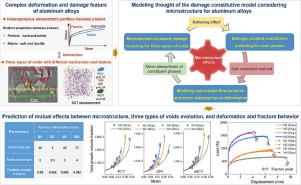International Journal of Plasticity ( IF 9.4 ) Pub Date : 2022-07-23 , DOI: 10.1016/j.ijplas.2022.103390 L. Xing , P.F. Gao , M. Zhan , Z.P. Ren , X.G. Fan

|
Aluminum alloys undergoing deformation exhibit complex multi-type-void damage evolution driven by microscale heterogeneous deformation; in return, the accumulated damage evolution would affect the microscale heterogeneous deformation. Meanwhile, the above interaction depends significantly on the microstructure characteristics and determines the macroscale flow and ductile fracture behaviors. These make it difficult to model the deformation response and ductile fracture of aluminum alloys with various microstructures. Aiming at this issue, a micromechanics-based damage constitutive model considering the mutual effects between microstructure, micro/macro-scale deformation, and damage and fracture was developed in this study for deformation of aluminum alloys under tension-dominated loading conditions. During the modeling, the damage was characterized in terms of the evolutions of coexisting multi-type voids. The multiple-type voids were modeled separately as functions of the local micro-strain/stress of their respective phases and microstructure characteristics according to the micromechanical mechanisms. Furthermore, a self-consistent method was employed to calculate the heterogeneous micro-strain/stress of phases and the overall macroscale flow behavior of the multiphase aggregate. In particular, the constitutive behavior of each phase in the self-consistent method was modeled by coupling the softening effect of void evolution and microstructure characteristics, thus the interaction between microscale heterogeneous deformation and damage evolution was captured. The model parameters were determined by matching the calculated and experimental evolutions of the multi-type voids measured via in-situ synchrotron radiation X-ray computed tomography and load-displacement curves during deformation. Applied to the 2219 aluminum alloy, this model accurately predicts the flow stress, damage evolution and fracture behavior under various microstructures and those of tailor-welded blanks with a gradient microstructure. Furthermore, the model clarifies the mutual effects between the microstructure, damage evolution and deformation behavior of aluminum alloys. The developed model can also be generalized to other multiphase metals containing a distribution of hard-brittle particles. And it is thus believed to be with a well general prediction for the deformation response and ductile fracture of this kind of multiphase metals with various microstructures or gradient microstructures, and further facilitates the understanding of their complex damage evolution and flow behavior.
中文翻译:

基于微观力学的铝合金损伤本构模型
发生变形的铝合金呈现出由微尺度异质变形驱动的复杂的多型空洞损伤演化;作为回报,累积的损伤演变会影响微尺度异质变形。同时,上述相互作用在很大程度上取决于微观结构特征,并决定了宏观流动和韧性断裂行为。这些使得难以模拟具有各种微观结构的铝合金的变形响应和延性断裂。针对这一问题,本研究建立了一种基于微观力学的损伤本构模型,该模型考虑了显微组织、微观/宏观尺度变形以及损伤和断裂之间的相互影响,用于拉伸主导加载条件下的铝合金变形。在建模过程中,损伤的特征在于共存的多类型空隙的演变。根据微机械机制,将多种类型的空隙分别建模为它们各自相的局部微应变/应力和微观结构特征的函数。此外,采用自洽方法计算相的异质微应变/应力和多相骨料的整体宏观流动行为。特别是,通过耦合空隙演化的软化效应和微观结构特征,对自洽法中各相的本构行为进行了建模,从而捕捉到了微尺度非均匀变形与损伤演化之间的相互作用。模型参数是通过匹配通过原位同步辐射 X 射线计算机断层扫描和变形过程中的载荷-位移曲线测量的多类型空隙的计算和实验演变来确定的。该模型应用于 2219 铝合金,可准确预测各种显微组织和具有梯度显微组织的拼焊板坯的流动应力、损伤演变和断裂行为。此外,该模型阐明了铝合金的微观结构、损伤演变和变形行为之间的相互影响。所开发的模型也可以推广到其他含有硬脆颗粒分布的多相金属。











































 京公网安备 11010802027423号
京公网安备 11010802027423号